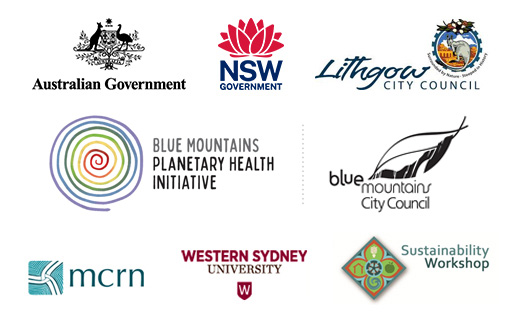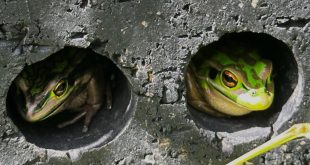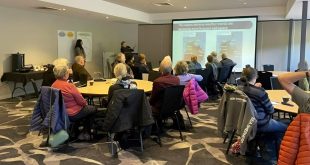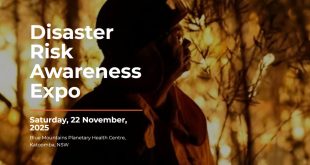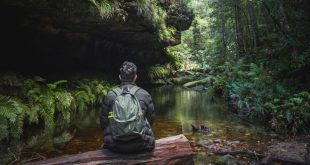
Bill Dixon in his rainforest garden
Story and photos by Hamish Dunlop
Bill Dixon has cultivated a rainforest garden on a ridge in South Springwood. He talks about how growing rainforest species can be an adaptive response to local climate conditions.
Key Points:
- Bill Dixon, a Blue Mountains resident with expertise in natural systems management, has a garden filled with rainforest species.
- Bill believes rainforest gardens can be an adaptation strategy for a changing climate, providing shade and cooler temperatures.
- Rainforest species may also help mitigate against ember attack in bushfires due to their dense foliage and less flammable leaves.
Bill Dixon has spent a lifetime involved with biology and natural systems management. He and his family have lived in the Blue Mountains for more than 25 years. Before they moved to Springwood, they lived near Excelsior Reserve in Northmead. Their block faced north and it was hot, so Bill started to plant rainforest species “to air condition the joint”. By the time they left, he had amassed over 150 different species.
In Springwood, he has 84 species growing. In the front garden these are mainly shrub level, but there are also mid-canopy species such as tulip wood, white cedar and Lepiderema pulchella, commonly known as fine-leaved tuckeroo. There are various edible species such as native peach, native guava, lilly pillies and citrus, including finger limes. It’s a hot day, but the air is cool and moist under the shade of the tulip woods.

Mature tulip woods (centre).
Bill brought some rainforest species form Northmead and planted them in 1996/97, such as the tulip woods on the drive. Most of the species in his current garden come from NSW, but there are a few from Queensland. Plants have also been sourced locally from the Glenbrook Australia Plant Society Nursery and Plant Rescue in Katoomba. Bill has germinated a wide variety of plants too.
The risk of fire
Like many of us in the Mountains, Bill is aware of the potential for fire. He says that when it comes to the destruction of homes, around 80% are lost through ember attack. Other causes include radiant heat from fire, direct flame contact, heat that creates differences in pressure inside and outside a building and strong winds.
Architect and fire expert Nigel Bell says there are various ways that embers can lead to ignition. These include direct contact with combustible materials, entry through small gaps in a building’s structure, the lighting of nearby materials and sparks entering roof cavities from gutters and at the eaves.
Various techniques can be used to mitigate against these causes. These include installing gutter guards that keep leaves from accumulating and ember guards that cover small entry points, particularly those that enable sparks or embers to enter roof cavities.
Nigel recommends that separating the most flammable vegetation (including trees) away from the house is a key firewise garden strategy.
For more information about how to prepare your home for fire check out the fact sheets on the RFS website here
Experimenting with rainforest planting
Bill tells me his rainforest garden is an experiment. In Springwood he’s learned how to grow rainforest species on a sandstone ridge. He’s also been thinking for some time about the relationship between fire factors such as ember attack and vegetation species near or around buildings.
His views have been developed over decades. They’re informed by his scientific background, witnessing the 2001, 2013 and 2019/20 fires and his work history, notably seven years as Manager at Local Land Services.
Bill’s expertise is highly sought after. He is currently the Chair of National Parks and Wildlife Service’s Regional Advisory Committee (Blue Mountains Branch), also sitting on their World Heritage Advisory Committee and on the Advisory Committee of Blue Mountains City Council’s Planetary Health Initiative.
Fire resistance of rainforest species
He thinks that rainforest plantings can in some circumstances mitigate against fire, mainly ember attack. “Rainforest canopy species have densely packed foliage and less flammable leaves than eucalypts. In general, this makes them more effective ember screens.”
Bill tells me that rainforest leaves are less woody than eucalypt species. “They transpire more vigorously and are more water rich.” he says. This means they can absorb greater radiant heat than dry sclerophyll species before they burn, resisting fire for longer.”
One of the ways embers start localised fires is by igniting combustible materials. Bill says that rainforest species combined with planting arrangements can reduce the amount of combustible matter and increase the water content of what remains.
“Because rainforest species are densely packed – sometimes more than one plant per square metre – they can reduce the ability of embers getting into the leaf litter. Rainforest leaf litter is also quite different and less flammable than dry sclerophyll species.”

A combination of eucalypt, but predominantly rainforest leaf litter.
Compared to rainforest leaf litter, eucalypt species drop leaves that are woody and form loose piles. Bill says this means it’s more difficult for decomposers such fungi to break them down. There is more oxygen available in the litter to feed fire too.
Many rainforest species drop and rapidly regrow leaves all year round. Because they are less woody and not so nutrient rich, they decompose more easily. This reduces the amount of fuel on the ground and keeps the soil moist.
Bill has a mix of rainforest and dry sclerophyll canopy species in his garden including bloodwoods and eucalypts. He’s noticed that rainforest leaf litter aids in breaking down woodier leaves. He’s very clear though that the best method of reducing leaf litter ignition is to remove it all together.
He says one of the interesting features of rainforest plantings is how they create their own microclimate. Shade and evaporative cooling increase humidity and decrease temperature. This can increase soil moisture.
On balance, these factors make rainforest species more resilient against bushfire than forests consisting of species such as eucalyptus, tea trees, banksias and grasses. On a larger scale, this could mean rainforest better resist flame and radiant heat attack. On a smaller scale it might limit the extent of ember incursions and point at which materials ignite.

Densely packed rainforest species. 22 in a 6m by 3m plot.
Bill thinks that in our evolving fire landscape we should look at all the ways we can mitigate against the impacts of bushfire. He doesn’t think that planting rainforest species alone is the solution, or that we should not use traditional methods of fire prevention. The combination of water tanks and a generator/pump to wet down property and extinguish spot fires or gutter guards are tested measures to prevent and defend.
Further discussion
Bill’s views are supported by academic research and experts in the field of fire management and mitigation. One of these is Chris Brack, Associate professor (Honorary) at Fenner School of Environment & Society, Australian National University.
Chris says that tree ‘screens’ can be very effective wind breaks and so slow down or block wind-blown embers. “These screens are ideally semi-porous, so they don’t cause chaotic turbulence on the down-wind side but still cause any airborne embers to fall early. This works when the trees are far enough away from the buildings.”
He also thinks that keeping trees watered can be an effective fire mitigator. Greywater is an excellent source of water for this purpose. Chris says, “Watering can reduce the quantity of dead and dry leaves that can become fuel. It may increase decomposition of ground litter and may increase the relative humidity (RH) as the trees can continue to transpire.”
He continues, “High RH is one of the factors that results in a hot fire. Rainforest species don’t tend to stop transpiring even under harsh conditions that may lead to death, but if the water can be kept up it will also reduce the harshness of those conditions. So, a forest barrier of well-watered rainforest species may improve things with little risk of making them worse.” The caveat is trees that are consumed by a ladder fire that has made it into the canopy. When a fire is big enough and hot enough, the options to fight it are limited.
Bill agrees. “When thinking about the effectiveness of fire mitigation strategies, it’s important to know what kind of fire exposure is being discussed. For example, a screen of rainforest trees might be effective at catching embers of a particular size, but might burn if exposed directly to a sclerophyll-fuelled crown fire.”
Climate change hope
Bill says that climate change will be characterised by persistence as much as loss. He says we need to focus on minimising loss, but that change is inevitable. “We have to focus on what quality can be retained that still makes natural systems really worthwhile to work with, even if we lose iconic things.”
While at Land Services he ran workshops about climate change adaptability for policy makers. He says management is intrinsically conservative and based on best practice, but this is problematic when it comes to climate change. “We’re going into uncharted territory, so we need to look to the future and think about potential solutions.”
He gives the example of being a proponent of only revegetating with provenance species. “Climate change means climate zones are moving. Mixing up plant genetics by anticipating future change is an adaptation strategy. In fact, the CSIRO has a climate projection tool. It enables you to put in a date and location and it will provide you with a comparable current location.”
Bill knows from experience that growing rainforest species on the Blue Mountains plateau requires care, but he says that humans have always grown plants for their own uses. “Look at the gardens in Leura and people’s vegetable patches. We don’t think twice about augmenting the local growing conditions whether it’s nutrients or water. It’s just that using plants and landscape design to mitigate against bushfire risk is a relatively new idea in the public consciousness, but it’s something we should explore.”
Understanding the flammability of different plants
To learn more about the flammability of different plants, Lesley Corbett has written a highly recommended book: Safer Gardens – Plant Flammability & Planning For Fire
The CFA (Country Fire Authority) in Victoria have also created an excellent resource for landscaping for bushfire which you can download here >
Bushfire behaviour is always unpredictable, with increasing impacts on properties, landscape, buildings and gardens. Specific local onsite consideration is required at all times, rather than reliance on more general advice. The Association of Bell Clarence & Dargan Inc (ABCD Inc) has compiled some excellent resources and produced comprehensive videos on how to prepare your home and property for bushfires
Take Action:
- Consider planting suitable rainforest plants that can create a cooler microclimate and potentially offer some fire mitigation benefits, especially from embers. Bill Dixon’s experience shows it can be done even in non-rainforest areas with proper care.
- Learn what not to plant with the info on the Weeds Blue Mountains site
- Learn more about fire mitigation strategies for your region – research and implement a variety of fire mitigation strategies based on your specific area’s recommendations.
- Find out about the best native plants for bushfire prone locations with this BMCC resource
Share this article:
This story has been produced as part of a Bioregional Collaboration for Planetary Health and is supported by the Disaster Risk Reduction Fund (DRRF). The DRRF is jointly funded by the Australian and New South Wales governments.
